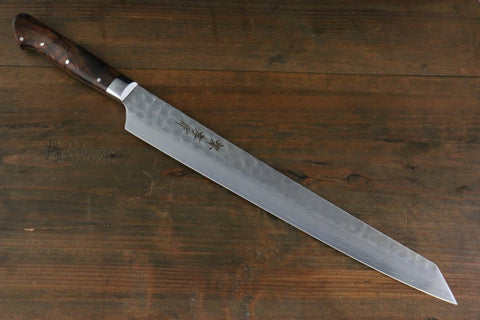There are a lot of different Japanese knife types, but don't be put off, here's a simple explanation of each of the knife types, and what they are best used for:

This is a multi-purpose, large bladed knife that you can use for everything. Typically these are light strong knives, and hold a very sharp blade easily. They are also easy to sharpen due to the shape of blade Blades range from 180mm to 240mm normally, with 210mm being the most common and popular size. The blade profile is great for cutting in a rocking type motion.

This is a smaller blade mainly used for chopping herbs, veg, or perhaps even filleting a fish. A vital knife for when a Gyuto is too big. Blades are normally between 120mm and 150mm

Similar to a Gyuto chef’s knife, the Santoku offers a large light blade with a taller profile and a flatter belly, making the knife excellent for a more ‘up and down’ chopping motion for meat, fish or vegetables. Blades vary from 165mm to 210mm, with 180mm being the most popular. There are also smaller Santoku knives available around 135mm which make a great alternative to a petty utility knife.

Similar to a petty utility knife, but typically shorter blades. These are great for peeling and trimming. Blades are typically between 60mm and 90mm, with 80mm being very popular.

A long, thin, hard blade designed for cutting, this makes an excellent knife for filleting, carving, or slicing meat and vegetables

The Nakiri has a straight blade perfect for precise vegetable work, such as julienne, brunoise or allumette. Due to its strength it is also an excellent choice for chopping large hard vegetable such as squash or pumpkin.

Usuba is similar in purpose to Nakiri, but has a thinner single bevel blade. It's a more precise knife and great for detail, hugely popular in Japanese professional kitchens along with Deba and Yanagiba.

Typically a stronger, heavier, thicker single bevel blade originally intended for fish, but ideal for butchery. An excellent knife if you work a lot with fish or meat.

Simple really, long serrated blades for cutting bread, but in the Japanese style
